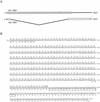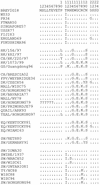Characterization of the 1918 "Spanish" influenza virus matrix gene segment
- PMID: 12368314
- PMCID: PMC136643
- DOI: 10.1128/jvi.76.21.10717-10723.2002
Characterization of the 1918 "Spanish" influenza virus matrix gene segment
Abstract
The coding region of influenza A virus RNA segment 7 from the 1918 pandemic virus, consisting of the open reading frames of the two matrix genes M1 and M2, has been sequenced. While this segment is highly conserved among influenza virus strains, the 1918 sequence does not match any previously sequenced influenza virus strains. The 1918 sequence matches the consensus over the M1 RNA-binding domains and nuclear localization signal and the highly conserved transmembrane domain of M2. Amino acid changes that correlate with high yield and pathogenicity in animal models were not found in the 1918 strain. Phylogenetic analyses suggest that both genes were mammalian adapted and that the 1918 sequence is very similar to the common ancestor of all subsequent human and classical swine matrix segments. The 1918 sequence matches other mammalian strains at 4 amino acids in the extracellular domain of M2 that differ consistently between avian and mammalian strains, suggesting that the matrix segment may have been circulating in human strains for at least several years before 1918.
Figures



Similar articles
-
Large-scale sequence analysis of M gene of influenza A viruses from different species: mechanisms for emergence and spread of amantadine resistance.Antimicrob Agents Chemother. 2009 Oct;53(10):4457-63. doi: 10.1128/AAC.00650-09. Epub 2009 Aug 3. Antimicrob Agents Chemother. 2009. PMID: 19651904 Free PMC article.
-
Influenza a virus M2 ion channel activity is essential for efficient replication in tissue culture.J Virol. 2002 Feb;76(3):1391-9. doi: 10.1128/jvi.76.3.1391-1399.2002. J Virol. 2002. PMID: 11773413 Free PMC article.
-
Nucleotide sequence of RNA segment 7 and the predicted amino sequence of M1 and M2 proteins of FPV/Weybridge (H7N7) and WSN (H1N1) influenza viruses.Virus Res. 1988 May;10(2-3):263-71. doi: 10.1016/0168-1702(88)90021-4. Virus Res. 1988. PMID: 3414185
-
Resistance characteristics of influenza to amino-adamantyls.Biochim Biophys Acta. 2011 Feb;1808(2):547-53. doi: 10.1016/j.bbamem.2010.06.018. Epub 2010 Jun 27. Biochim Biophys Acta. 2011. PMID: 20599692 Review.
-
[Emergence of amantadine-resistant influenza A viruses].Uirusu. 2001 Dec;51(2):135-41. Uirusu. 2001. PMID: 11977753 Review. Japanese. No abstract available.
Cited by
-
Detection of Ancient Viruses and Long-Term Viral Evolution.Viruses. 2022 Jun 18;14(6):1336. doi: 10.3390/v14061336. Viruses. 2022. PMID: 35746807 Free PMC article. Review.
-
The beginning and ending of a respiratory viral pandemic-lessons from the Spanish flu.Microb Biotechnol. 2022 May;15(5):1301-1317. doi: 10.1111/1751-7915.14053. Epub 2022 Mar 22. Microb Biotechnol. 2022. PMID: 35316560 Free PMC article.
-
Microorganisms as Shapers of Human Civilization, from Pandemics to Even Our Genomes: Villains or Friends? A Historical Approach.Microorganisms. 2021 Dec 6;9(12):2518. doi: 10.3390/microorganisms9122518. Microorganisms. 2021. PMID: 34946123 Free PMC article. Review.
-
The 1918 Influenza Pandemic and Its Legacy.Cold Spring Harb Perspect Med. 2020 Oct 1;10(10):a038695. doi: 10.1101/cshperspect.a038695. Cold Spring Harb Perspect Med. 2020. PMID: 31871232 Free PMC article. Review.
-
The dynamic proteome of influenza A virus infection identifies M segment splicing as a host range determinant.Nat Commun. 2019 Dec 4;10(1):5518. doi: 10.1038/s41467-019-13520-8. Nat Commun. 2019. PMID: 31797923 Free PMC article.
References
-
- Baez, M., P. Palese, and E. D. Kilbourne. 1980. Gene composition of high-yielding influenza vaccine strains obtained by recombination. J. Infect. Dis. 141:362-365. - PubMed
-
- Basler, C. F., A. H. Reid, J. K. Dybing, T. A. Janczewski, T. G. Fanning, H. Zheng, M. Salvatore, M. L. Perdue, D. E. Swayne, A. Garcia-Sastre, P. Palese, and J. K. Taubenberger. 2001. Sequence of the 1918 pandemic influenza virus nonstructural gene (NS) segment and characterization of recombinant viruses bearing the 1918 NS genes. Proc. Natl. Acad. Sci. USA 98:2746-2751. - PMC - PubMed
-
- Bauer, C. M., L. H. Pinto, T. A. Cross, and R. A. Lamb. 1999. The influenza virus M2 ion channel protein: probing the structure of the transmembrane domain in intact cells by using engineered disulfide cross-linking. Virology 254:196-209. - PubMed
Publication types
MeSH terms
Substances
LinkOut - more resources
Full Text Sources
Other Literature Sources


